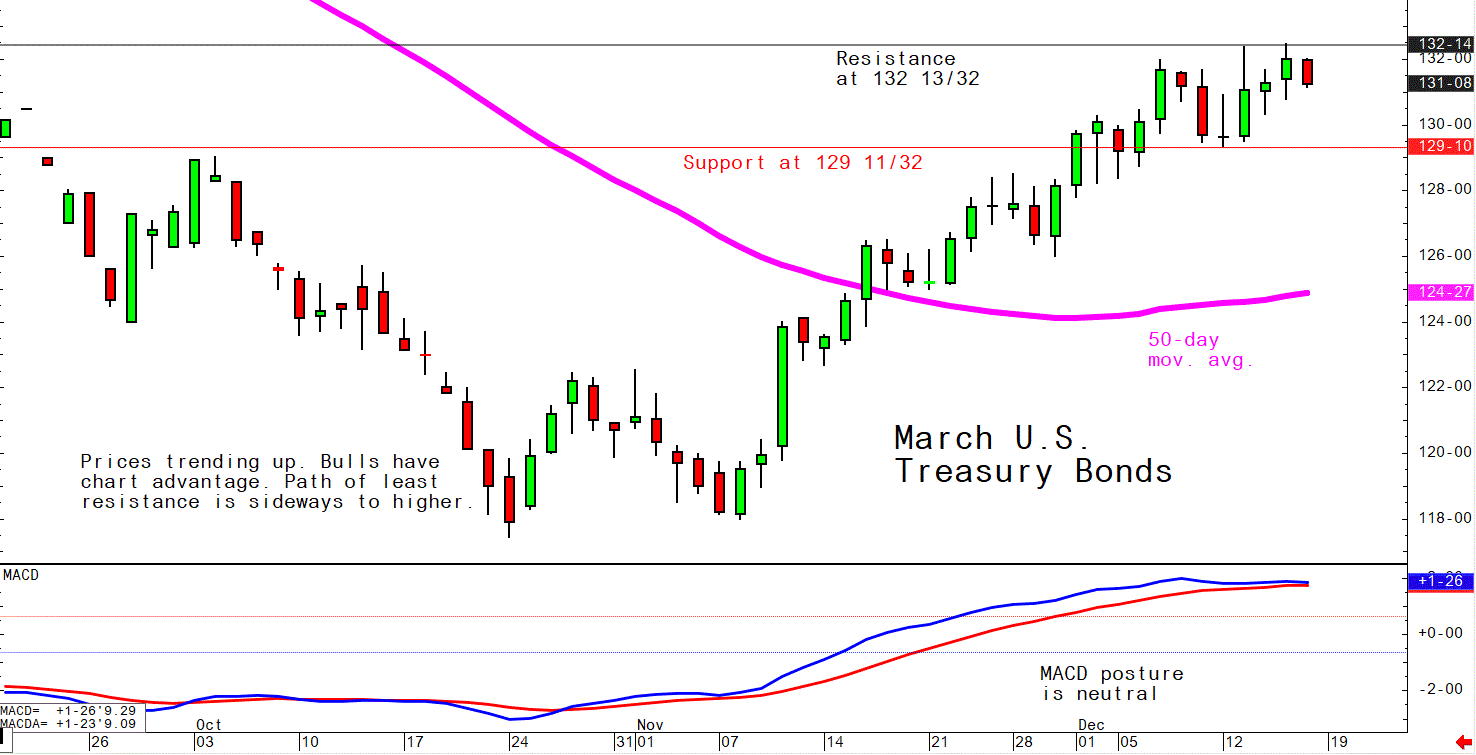Stagflation Tone Prevalent as Retail Sales, Other Data Suggest U.S. Recession Ahead

Defense/WRDA bill heads to White House | Senate clears CR with omnibus bill next week
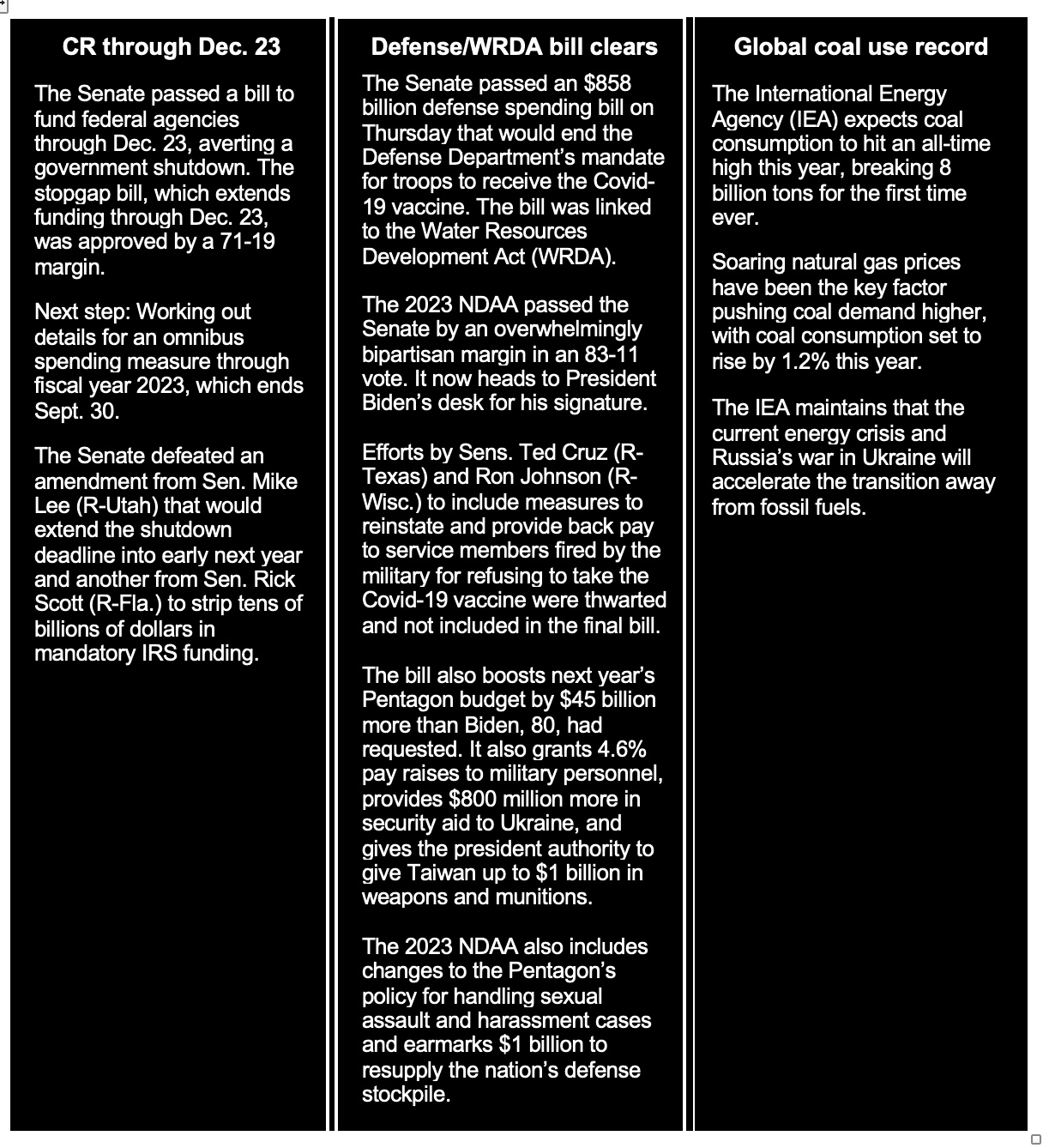
|
In Today’s Digital Newspaper |
Weaker-than-expected retail sales in November pummeled market sentiment on Thursday and raised the odds that the Federal Reserve's inflation-fighting interest rate hikes would push the economy into recession. In talks with traders and analysts, the subdued market done is clearly evident. The weak retail sales report means that spending faltered just as the holiday season started, a critical time for retailers to ramp up profits and get rid of excess inventory. Investors weren't too happy about that.
Most American voters think the economy will be in worse shape in 2023, a WSJ poll finds.
Roughly two-thirds say the nation’s economic trajectory is headed in the wrong direction. The survey, conducted Dec. 3-7, suggests a recent burst of positive economic news — moderating gas prices and a slowing pace of inflation — hasn’t altered the way many feel about the risk of a recession, something many economists have forecast as likely. Among Republicans, 83% expect the economy to worsen. Slightly more than half of independents feel that way, while 22% of Democrats do.
As Christmas nears, U.S. lawmakers finally step up its usual slow pace. The combined defense/WRDA bill is on the way to President Joe Biden’s desk, and the Senate cleared another stopgap spending bill for lawmakers by the end of next week to finally settle on an omnibus spending bill for fiscal year 2023, that is expected to include several policy riders, including an extension of the Emergency Relief Program for eligible 2022 crops and livestock, and a possible $350 million aid package for the rice industry. The Senate passed an $858 billion defense-policy bill. The annual National Defense Authorization Act authorizes U.S. military leaders to purchase new weapons and increases pay for service members. Lawmakers voted 83-11 to pass the measure; it now goes to President Biden’s desk for his signature. Among its policy proposals: $800 million for security assistance to the Ukrainian armed forces, an overhaul of the military-justice system and the end of a Covid-19 vaccine mandate for members of the military.
Russia fired a barrage of missiles targeting energy infrastructure in Kyiv and other Ukrainian cities, part of a campaign to wear down its adversary while rebuilding for an expected renewed ground offensive.
A U.S. audit regulator said it has complete access to inspect China-based audit firms for the first time, resetting a three-year clock for delisting Chinese companies. The development removes (for now) the threat that they could be delisted from U.S. stock markets for failing to meet disclosure rules.
Carbon-credit investors pay up for quality projects that are seen as more effective in cutting greenhouse-gas emissions.
Europe’s economy likely contracted at the end of 2022 but showed signs of resilience.
Japan moves to double military spending, with a wary eye on China. The Japanese cabinet approved the first update to the country’s official security strategy in nine years, elevating Beijing over North Korea as the top threat. Meanwhile, China and Japan are in talks for a trip by Japanese foreign minister — Yoshimasa Hayashi could become Tokyo’s first top diplomat to visit since 2019.
On the political front, Kyrsten Sinema filed paperwork for her 2024 Senate candidacy as an independent.
|
MARKET FOCUS |
Equities today: Global stock markets were mostly lower overnight. In Asia, Japan -1.9%. Hong Kong +0.4%. China flat. India -0.8%. In Europe, at midday, London -1.3%. Paris -1.3%. Frankfurt -0.8%. U.S. Dow opened up around 220 points lower, amid five-week lows. Futures are sharply lower on momentum from Thursday’s selling. Today is a Quadruple Witching options expiration and it could cause some intense volatility as many traders had been positioned for a year-end rally, and as those hopes are being dashed, some book-squaring is possible. This time around, $4 trillion in options contracts are set to expire, possibly making Friday the busiest session for options traders this year, noted Rocky Fishman, head of index volatility research at Goldman Sachs. Meanwhile, analysts warned of growing volatility for the stock market in coming weeks as economic uncertainty leaks into the holidays and the start of earnings season in January. Markets might be particularly prone to "wider swings" in the last two weeks of the year due to the absence of important economic data releases, one expert said.
Says the Sevens Report: Investors search for the answers to the two key questions:
1) How fast will inflation decline?
2) How bad will the economy get?
“The answers to those, and not whether the Fed hikes to 4.875% or 5.125%, will determine the fate of stocks over the first several months of 2023, because investors will need to know those answers to determine A) Expected 2023 earnings and B) The right market multiple.
“Between now and year-end, however, we shouldn’t be shocked by a continued selloff as investors, who were hoping for a Santa Claus rally, are largely “throwing in the towel” and instead focusing on harvesting tax losses (and today could be especially volatile with the looming quarterly options expiration).”
Stagflation gaining ground as despite the improving CPI data released earlier in the week, the sharp drop off in growth is outpacing the slowing rate of inflation pressures, especially in the United States.
U.S. equities yesterday: Stock markets around the globe came under pressure Thursday in the wake of U.S. and other central banks opting to increase interest rates again as they seek to fight inflationary pressures. The Dow ended down 764.13 points, 2.25%, at 33,202.22. The Nasdaq declined 360.36 points, 3.23%, at 10,810.70 (Thursday marked the index's 84th move of 2% or more in either direction this year). The S&P 500 fell 99.57 points, 2.49%, at 3,985.75.
Agriculture markets yesterday:
- Corn: March corn rose 3 cents to $6.53 1/2.
- Soy complex: January soybeans fell 8 3/4 cents to $14.73 1/2. January soymeal fell $4.80 to $455.30. January soyoil rose 27 points to 63.82 cents.
- Wheat: March SRW wheat rose 8 cents to $7.57 1/4, the contract’s highest close since Dec. 2. March HRW wheat gained 10 1/4 cents to $8.60 1/2. March spring wheat rose 1 1/2 cents to $9.18 3/4.
- Cotton: March cotton fell 34 points at 81.03 cents.
- Cattle: February live cattle fell 85 cents to $154.85, the lowest close since Dec. 8. January feeder futures sank 55 cents to $183.05.
- Hogs: February lean hogs fell $1.75 to $81.65, the contract’s lowest close since Oct. 11.
Ag markets today: Corn and soybeans were weaker this morning after two-sided price action overnight, while wheat futures were mostly firmer. As of 7:30 a.m. ET, corn futures were trading around a penny lower, soybeans were mostly 4 to 5 cents lower and wheat futures were steady to 2 cents higher. Front-month crude oil futures were around $1.75 lower and the U.S. dollar index was modestly weaker this morning.
Technical viewpoints from Jim Wyckoff:
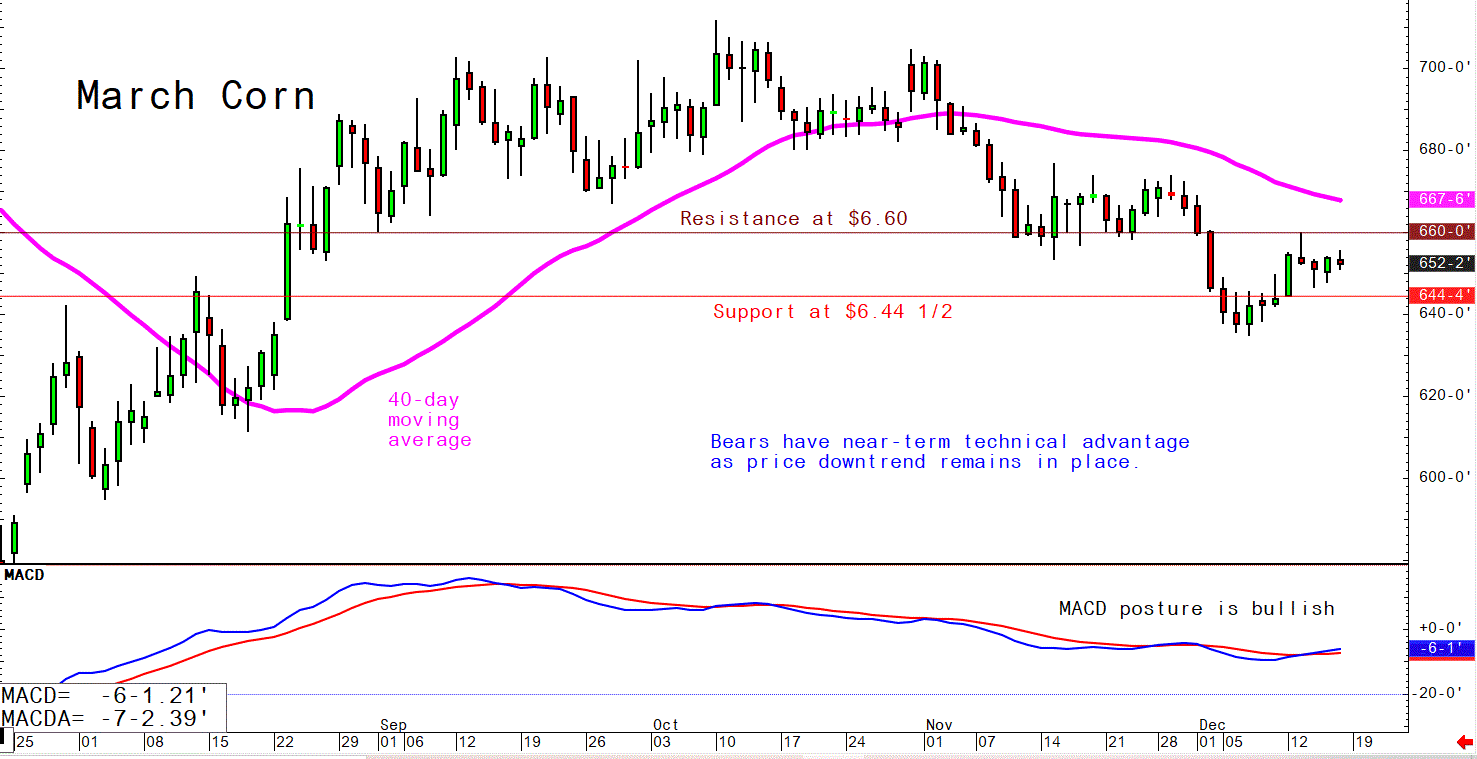

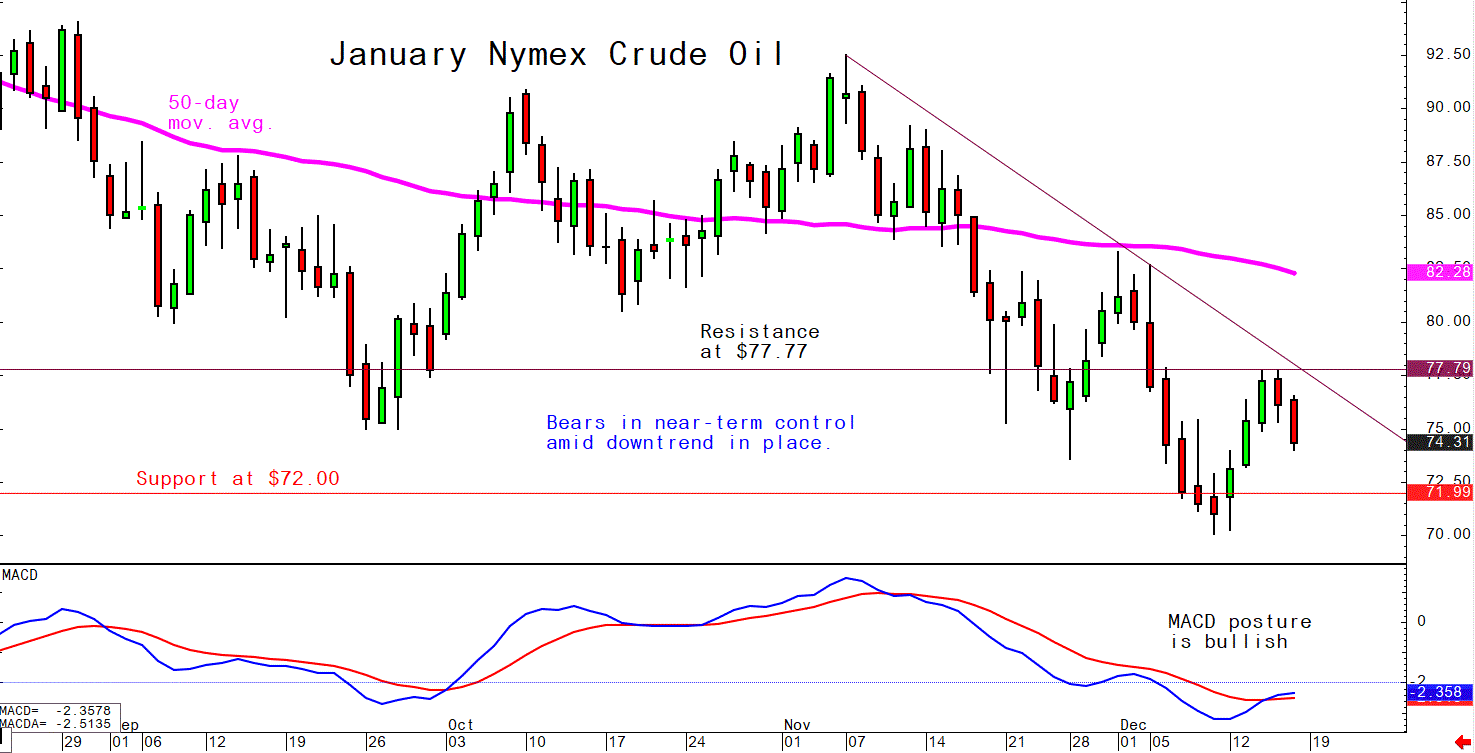
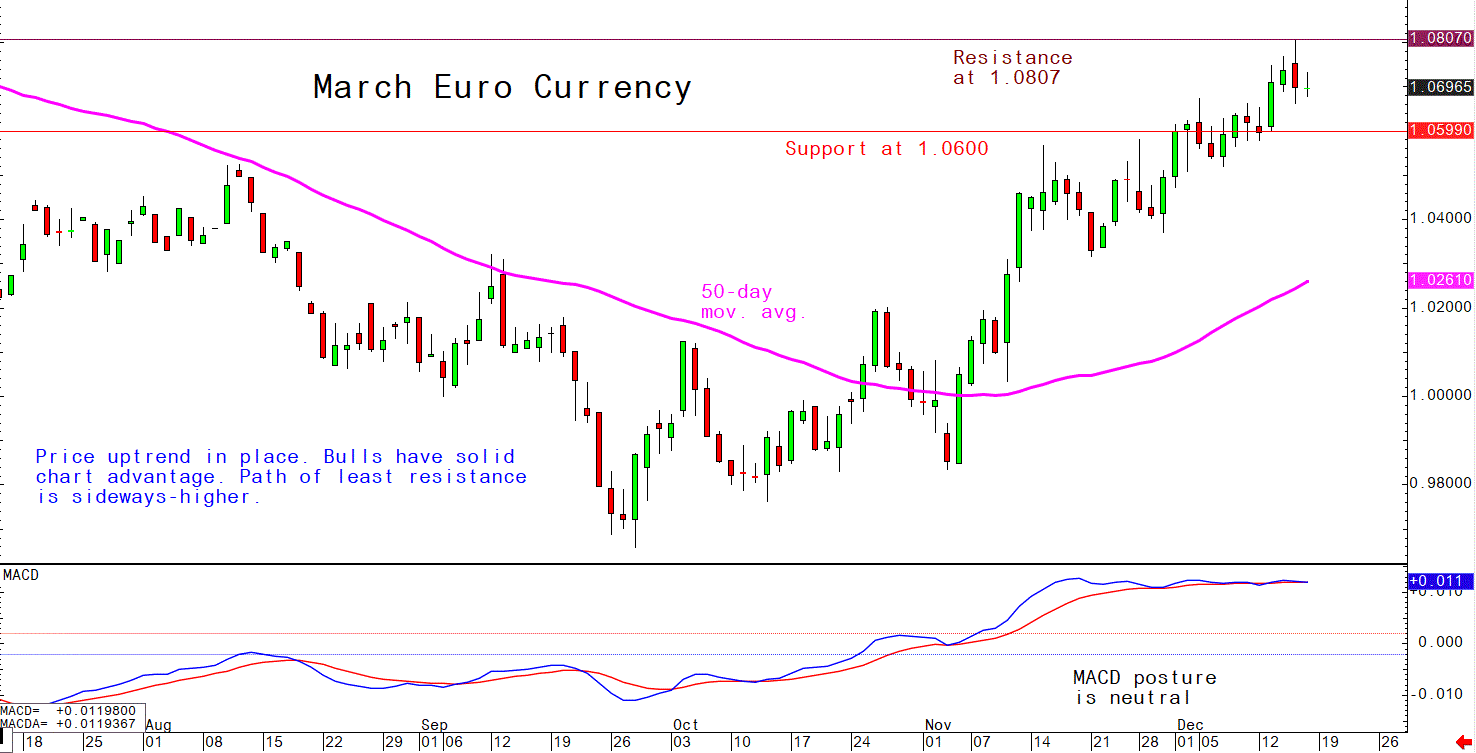
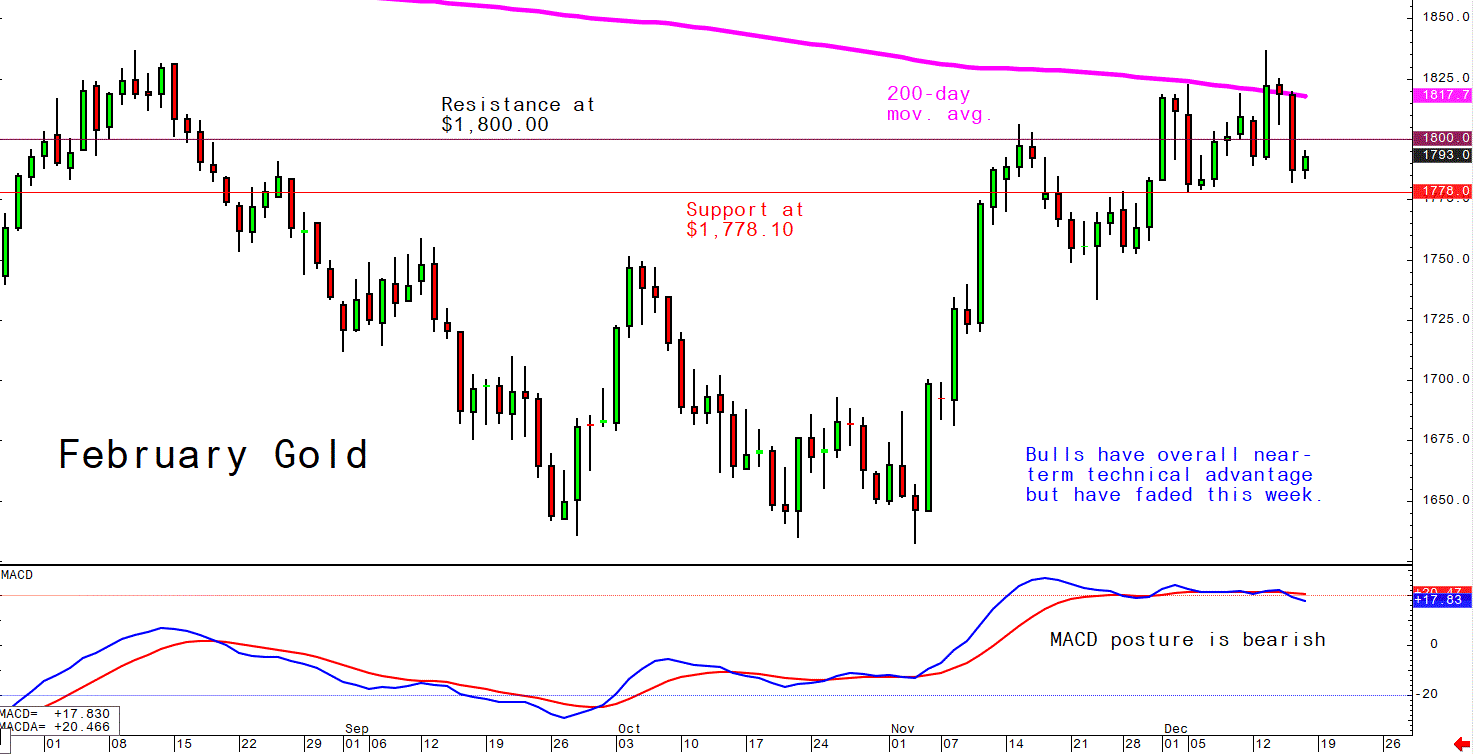
On tap today:
• S&P Global's preliminary U.S. manufacturing index for December, due at 9:45 a.m. ET, is expected to hold at 47.7, unchanged from a final November reading. S&P's services index is forecast to tick up to 46.5 from 46.2.
• Baker Hughes rig count is out at 1 p.m. ET.
• CFTC Commitments of Traders report, 3:30 p.m. ET.
• Federal Reserve speakers: New York's John Williams on Bloomberg TV at 8:30 a.m. ET, San Francisco's Mary Daly on the economy and monetary policy at 12 p.m. ET, gov. Michelle Bowman on community banks at 1 p.m. ET, and Cleveland's Loretta Mester on Bloomberg TV at 3:30 p.m. ET.
A majority of voters think the economy will be in worse shape in 2023 than it is now and roughly two-thirds say the nation’s economic trajectory is headed in the wrong direction, the latest Wall Street Journal poll shows (link)
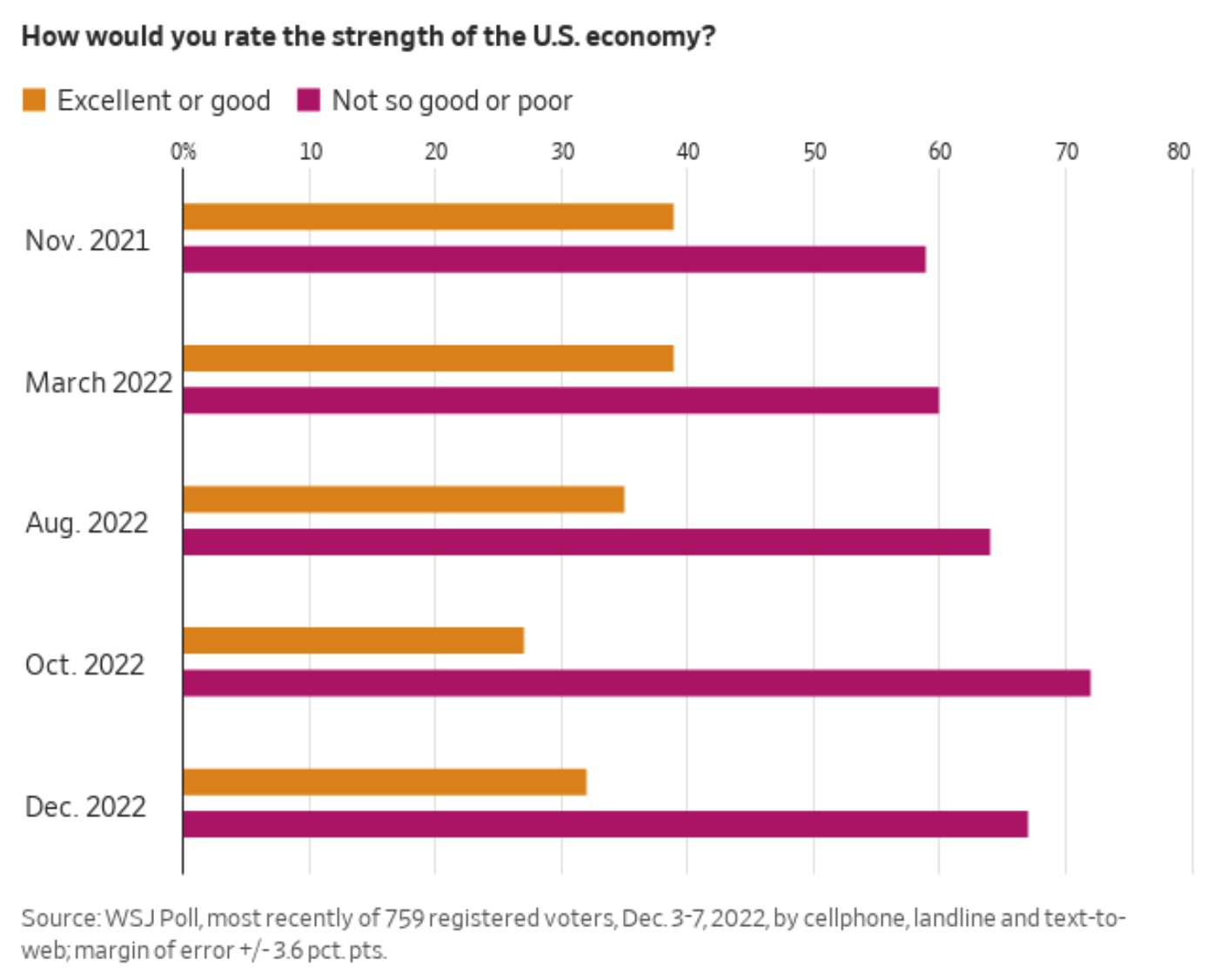
The consumer price inflation in the Euro Area was revised to 10.1% year-on-year in November 2022, slightly up from a preliminary estimate of 10.0%. The rate slowed for the first time since June 2021 from October's record high of 10.6%, but remained well above the European Central Bank's mid-point target of 2.0%, suggesting policymakers will be raising interest rates for some time. Energy prices rose at a softer 34.9% (vs 41.5% in October), but remained the largest contributor to the overall price increase. Meanwhile, inflation was little changed for both services (4.2% vs 4.3%) and non-energy industrial goods (6.1%, the same as in October), while it picked up for food, alcohol & tobacco (13.6% vs 13.1%). The core rate, which excludes volatile items such as energy and food, held steady at an all-time high of 5.0%.
The S&P Global Eurozone Composite PMI increased to 48.8 in December of 2022 from 47.8 in November, beating market forecasts of 48, preliminary estimates showed. The reading pointed to the sixth straight month of a fall in private sector activity although at a more moderate pace, amid a reduced loss of orders, improving supply conditions, lower price pressures, and an uplift in business confidence. Both manufacturing (47.8 vs 47.1) and services (49.1 vs 48.5) shrank less than in the previous month. Still, the average PMI for the three months to December indicates the sharpest contraction since 2013 if pandemic lockdown months are excluded.
U.S. ports are sending warning signals about trade flows in the New Year. The first reports from gateways on both coasts suggest container imports turned sharply downward last month, the WSJ reports (link), while shipping executives say they are bracing for weak demand in the first part of 2023. A continuing decline at the Southern California ports deepened in November, with combined imports into Los Angeles and Long Beach plummeting 26% to the lowest level since the start of the pandemic. Inbound volumes at the ports of Savannah, Ga., and Charleston, S.C., also retreated. The figures signal that dockside business is feeling the impact of wavering U.S. consumer demand and weakening China exports. Container lines and ports usually get a wintertime bump from Lunar New Year volumes out of Asia, but executives aren’t expecting to celebrate much in the coming weeks.

Market perspectives:
• Outside markets: The U.S. dollar index was under mild pressure ahead of U.S. market action as several foreign currencies were firmer against the greenback. The yield on the 10-year US Treasury note was firmer, around 3.49%. Crude was lower, with U.S. crude around $74.40 per barrel and Brent around $79.55 per barrel. Gold and silver futures were mixed, with gold firmer around $1,792 per troy ounce and silver weaker around $23.06 per troy ounce.
• IEA: Coal use hit new record in 2022. Global coal consumption is expected to reach a record high in 2022, exceeding 8 billion tonnes for the first time and a 1.2% rise vs 2021, according to the International Energy Agency (IEA) (link). India’s demand is estimated to have risen by 7%, the European Union by 6% and China by 0.4%, the agency said. Further, they expect coal consumption will remain at that level to 2025 in part on strong demand in emerging Asian economies. Global coal-fired power generation is set to hit a new record of around 10.3 terawatt hours in 2022, while coal production is forecast to rise by 5.4% to around 8.3 billion tonnes, also a new record. They also expect coal production to reach a peak in 2023, but fall below 2022 marks by 2025. Link for details.
• Copper futures fell to the $3.7 per pound level, hovering firmly below the one-month high of $3.9 touched on December 14 as increasing concerns of a global recession hampered demand expectations. Still, threats to global supply softened the retreat in prices as lower production in South America continued to drive concerns of shortages. Output from top producer Chile slid 6.7% in the first three quarters of the year and mine protests in Peru hamper activity. Commodity trader Trafigura warned that global copper stocks have fallen to record lows with current inventories enough to supply world consumption for just 4.9 days, and mining giant Glencore estimates a supply shortfall of 50 million tonnes in 2023.
• U.S. seeks Colorado River drought plan from states by Feb. 1. California, Arizona, Navajo Nation and other U.S. states and tribes reliant on the Colorado River should aim to reach an agreement by Feb.1 on slashing water use in response to a devastating drought, the U.S. Interior Department’s David Palumbo said in an interview with Bloomberg. The U.S. gov’t will be ready to mandate water cuts by next summer if needed in absence of a deal, he said.
• NWS weather: Light snow and blizzard conditions gradually diminish across the northern Plains today... ...Heavy snow to impact portions of the Interior Northeast through the beginning of the weekend... ...Well below average temperatures enter the north-central U.S. by Sunday.
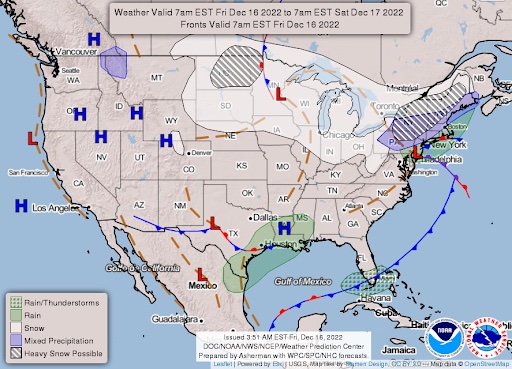
Items in Pro Farmer's First Thing Today include:
• Mostly weaker tone this morning
• Argentina’s planting remains slowed by drought
• Russian wheat export tax rises again
• India’s wheat planting up 3% from last year
• Cash cattle trade at steady/firmer prices
• February hog futures below cash index
|
RUSSIA/UKRAINE |
— Summary: Russian forces launched at least 60 missile strikes across Ukraine on Friday, officials said, reporting explosions in at least four cities. Russian forces fired cruise missiles from positions in the Black Sea, and used bomber aircraft as part of an effort to “massively distract the attention of the anti-aircraft defense, keeping it in tension,” Ukrainian Air Force spokesman Yurii Inhat told Ukrainian TV. Meanwhile, the U.S. Congress passed a massive defense spending bill Thursday that includes $800 million in support for Ukraine. The legislation, which now goes to President Joe Biden's desk for his signature, provides funding for the federal government to pay to produce weapons to send to the country, rather than drawing directly from current U.S. stockpiles. It would also expedite delivery of munitions to Ukraine and neighboring U.S. allies.
- The U.S. gov’t will ramp up its training of Ukrainian forces, both in terms of the number of soldiers involved and military tactics taught, U.S. officials said on Thursday. Beginning in January, Washington plans to train 500 Ukrainian troops per month, while also prioritizing more sophisticated battlefield strategies. “The idea here is to be able to give them this advanced level of collective training that enables them to conduct effective combined arms operations and maneuver on the battlefield,” said Air Force Brig. Gen. Pat Ryder.
- The U.S. State and Treasury Departments jointly announced sanctions against Russian oligarch Vladimir Potanin, the nickel mogul who is the nation’s second-wealthiest man, freezing all of his U.S. assets and barring him from entering the country. Up to this point, Potanin had largely avoided Western backlash amid the war in Ukraine, even as other Russian billionaires faced a mountain of sanctions.
- Russian ruble weakens to 7-month low. The Russian ruble weakened to 64.5 per USD in December, hovering close to levels last seen in May. Russia’s central bank underscored risks to the domestic currency, supporting inflationary risks as Western sanctions against Russia’s vital energy exports unbalanced terms of trade for the economy. Still, the ruble remains above levels prior to Russia’s invasion of Ukraine and cemented the rebound from the record-low of 150 touched in March. Capital controls and sanctions from the West drove Russian demand for foreign currencies to plummet, while monetary authorities mandated large fees and negative interest rates on currencies from states deemed “unfriendly,” removing a true market for foreign currencies for ruble holders. Meanwhile, increased demand for Russian energy from Asian countries limited the decline in exports.
- How Russia’s State TV spins the Ukraine War. Leaked emails detail how Russia’s biggest state broadcaster, working with the nation’s security services, mined right-wing American news and Chinese media to craft a narrative that Moscow was winning. Link for more via the NYT.
|
POLICY UPDATE |
— Senators voted 71-19 last night to send a one-week continuing resolution for fiscal year (FY 2023 to the president’s desk. Subcommittee leaders received top-line allocations for each of the 12 appropriations bills yesterday afternoon.
Text for the omnibus package is expected Monday, with weekend work ahead. Senate negotiators reached an agreement on the allocation levels for each of the bills, which allowed staffers to move ahead with drafting individual measures.
Work on several policy riders continues, including an extension of the Emergency Relief Program (ERP) for eligible 2022 crops and livestock, and a possible rice aid package around $350 million.
Timeline: Assuming the text comes Monday, the Senate would hold a cloture vote on Wednesday, and final passage by the Senate sometime Thursday. The measure would be sent to the House for action on Friday — 60 votes for the measure are needed in the Senate and 218 in the House. Once passed, the legislation would head to President Joe Biden’s desk for his signature. The House will come back into session Wednesday and remain so until the omnibus package is passed. There will be earmarks in this package sought by Republicans, a Democrat attempt to try to woo some GOP support.
— Senate clears annual defense policy bill, 83-11, linked with WRDA, Ukraine aid and repeal of Covid vaccine mandate for armed forces. The combined measure includes a major increase in the Pentagon’s budget. The bill will also grant another $800 million in taxpayer funds to the Ukraine Security Assistance Initiative as part of the U.S. effort to help Ukraine defend itself against an ongoing Russian invasion. The U.S. has already sent around $68 billion in humanitarian and military assistance to Ukraine in three major packages.
The military bill totals $858 billion. The defense package, the National Defense Authorization Act (NDAA), previously passed the House on Dec. 8 in a 350–80 vote.
Bottom line: The bill boosts next year’s Pentagon budget by $45 billion more than President Biden requested (including $19 billion just to keep up with inflation). It also grants 4.6% pay raises to military personnel, provides $800 million more in security aid to Ukraine, and gives the president authority to give Taiwan up to $1 billion in weapons and munitions. The 2023 NDAA also includes changes to the Pentagon’s policy for handling sexual assault and harassment cases and earmarks $1 billion to resupply the nation’s defense stockpile.
The Senate rejected an amendment proposed by Sens. Ron Johnson (R-Wis.) and Ted Cruz (R-Texas), which would have reinstated servicemembers removed exclusively for refusing the Covid-19 vaccine, as well as compensation for any salary and benefits lost due to the separation. The amendment failed, with 40 senators supporting it and 54 opposing it. Opponents were concerned about the precedent of rewarding military personnel who defied an order.
Manchin permitting overhaul dies again. Another effort by sometimes centrist Sen. Joe Manchin (D-W.Va.) to attach fossil fuel permitting reform to the bill also failed. As part of a private deal to win Manchin’s support for the $740 billion Inflation Reduction Act (climate bill), Senate Majority Leader Chuck Schumer (D-N.Y.) promised Manchin that permitting reform would be taken up before the end of the year. The procedural vote Thursday was 47-47, far short of the 60 necessary for consideration on the fiscal 2023 NDAA, which kills the permitting overhaul for now. It’s the third time since September that Republicans and Democrats in both chambers have nixed the West Virginia Democrat’s proposal to accelerate environmental review timeframes in the permitting of energy projects. Manchin could try again to insert the language into the omnibus spending measure that lawmakers are preparing now, and intend to pass by next Friday. Manchin’s proposal also sought completion of the Mountain Valley Pipeline, a natural gas pipeline running through West Virginia and Virginia.
— Water Resources Development Act (WRDA) attached to National Defense Authorization Act. The 427-page bill authorizes hundreds of projects and includes federal cost share. The WRDA bill is the main vehicle Congress uses to authorize the study, design, and construction of federal water infrastructure projects (flood control, ecosystem restoration, river navigation, and coastal port deepenings).
Details:
- The nearly $38 billion federal taxpayers are committing to 30 newly authorized or significantly altered Corps of Engineers construction projects. The 25 new project authorizations, totaling $30.4 billion in federal dollars, are spread across the country and Puerto Rico with price tags ranging from $10.5 million for harbor modifications in Glynn County, Georgia, to more than $21 billion for the “Coastal Texas Protection and Restoration” project (Texas provides $13 billion for the $34 billion project). the bill authorizes six “Modifications” to previously authorized projects. Price tags range from the paltry $19.8 million (all-federal) modification to Washington D.C.’s flood risk management project to the whopping $3.218 billion (also, all-federal) modification to Michigan’s New Soo Lock Construction project. A project on Central and Southern Florida’s Indian Lagoon is actually the costliest modification at $5.4 billion, but the non-federal sponsor will, supposedly, pick up half the tab.
- The measure includes 94 new feasibility studies and 12 new studies of modifications to existing water resources development projects. These are spread across the country and include projects for flood or coastal risk management, recreation opportunities, ecosystem restoration, and dam safety. Feasibility studies are a necessary step in the design and eventual construction of a particular Corps project. Congress directed the Corps to expedite the completion of a feasibility study for 25 particular projects, and if they find the project is justified, immediately move into pre-construction planning, engineering, and design (PPE&D) of those projects if a feasibility study determines a project is viable. Congress would have to give the Corps explicit authorization to move to designing the project. This pre-emptive authorization of PPE&D gives these projects a head start in getting designed and constructed, with taxpayer dollars at stake.
- Directs the Corps conduct a comprehensive study of increasing reservoir capacity across the South Pacific Division by using natural features or nature-based features upstream from reservoirs.
- Opportunities to add solar generation or even floating solar to Corps projects and facilities.
- A directive to expedite the study of adding barge lanes to the Houston, Texas, ship channel.
- A report on the economic benefits of recreational boating on the Great Lakes.
WRDA also includes numerous changes to water resources policy. Under Sec. 8312, federal taxpayers will now cover 90% of the $490 million navigation project at the port of Nome, Alaska, instead of the 75% promised when the project was authorized in 2020. A “special rule” requires federal taxpayers to cover increased costs for beach nourishment projects in Cape May, NJ, as well as Folly Beach, South Carolina, and both Wrightsville Beach and Topsail Beach and Vicinity, in North Carolina.
Of note, barge interests using the inland waterways will have their share of construction costs for locks and dams that make navigation feasible reduced to 35% from the general Treasury fund (instead of 50%) — permanently, and 65% from the Inland Waterway Trust Fund. The new WRDA removes a provision that would sunset the 65-35 cost-share back to 50-50 in 10 years. When including operation and maintenance costs, the inland waterway industry already benefits from a greater than 90% federal subsidy.
|
CHINA UPDATE |
— Covid-19 may have been connected to China’s bioweapons program: GOP report. A new unclassified report (link) released by Republican members of the House Intelligence Committee alleges that Covid-19 “may have been tied” to China’s biological weapons research program. The minority report states that “there are indications that SARS-CoV-2 may have been tied to China’s biological weapons research program and spilled over to the human population during a lab-related incident at the Wuhan Institute of Virology (WIV).”
“The Committee has not seen any indications that the Chinese military intentionally released SARS-CoV-2,” the report reads.
— The Public Company Accounting Oversight Board said it has secured complete access to inspect China-based audit firms for the first time, resetting a three-year delisting clock for Chinese companies on American stock exchanges.
— The U.S. put 36 Chinese companies on an export ban list, stepping up its bid to prevent Beijing from accessing advanced and sensitive technologies in areas such as semiconductors.
— Chinese hog prices plunged this week, and farmers are finding that consumption before the Lunar New Year festival in January isn’t as strong as expected. Link for more via Bloomberg.
|
TRADE POLICY |
— U.S./Mexico energy and GMO corn trade dispute talks ahead of Biden Visit. Just weeks before President Joe Biden’s planned visit to Mexico, talks on the neighbors’ biggest trade disputes continue with some reports saying energy trade negotiations have stalled due to the departures of negotiators from the Latin American nation’s side and its reluctance to make concessions. President Andrés Manuel López Obrador also has been unwilling to push for major changes in the nationalist energy policy, reports note. Lopez Obrador’s policy privileges Mexican state-owned oil producer Petroleos Mexicanos and the electricity provider known as CFE. The U.S. says this violates the U.S.-Mexico-Canada Agreement (USMCA) on trade, which went into force in 2020. Canada filed a similar request for talks over Mexico’s electricity policy. Lopez Obrador denies that his policies violate the pact, saying that the US must respect Mexico’s sovereignty. If a panel were to rule against Mexico, it might have to pay tariffs on as much as $30 billion in exports. Mexico’s economy ministry on Monday said that it presented to the U.S. and Canada a working plan to establish working groups this month and in January to try to resolve their concerns.
Regarding Mexico’s threatened ban on GMO corn effective 2025, USDA Secretary Tom Vilsack said the Biden administration is prepared to challenge the decree through the USMCA if Mexico doesn’t relent. A meeting today is scheduled with Mexican Foreign Secretary Marcelo Ebrard and other Mexican gov’t officials. Vilsack said he wants to see Mexico follow the rules of USMCA, but the alternative is “a process in which we trigger the dispute resolution (process) of the USMCA.” Vilsack, who aired the U.S. objections during a trip to Mexico on Nov. 28, told reporters he would take part in the new round of discussions. The corn decree by President Andrés Manuel López Obrador is not based on science, in the U.S. view, and could violate the USMCA, said Vilsack, who spoke to López Obrador during his November trip to Mexico City. “I was clear … that if the proposal doesn’t meet what we think is consistent with the science and what we think is consistent with the USMCA, that we absolutely will continue to work with the U.S. trade representative’s office to begin the process of triggering whatever needs to be triggered under the USMCA,” said Vilsack.
|
ENERGY & CLIMATE CHANGE |
— Carbon-credit market volume is keeping up with last year’s record, but prices are shifting under heightened scrutiny. The WSJ reports (link) they put higher prices on projects that were seen as more effective in reducing greenhouse-gas emissions, a sign of growing maturity in the nascent market. Nearly 172 million credits were purchased and retired by final buyers this year through Dec. 9, roughly equal to the amount sold to them during the same period last year, according to a Wall Street Journal analysis of carbon-market data. Exchange-traded volumes held steady at 108 million credits through November, compared with 112 million during the same period last year, according to data from Xpansiv, an exchange for carbon offsets.
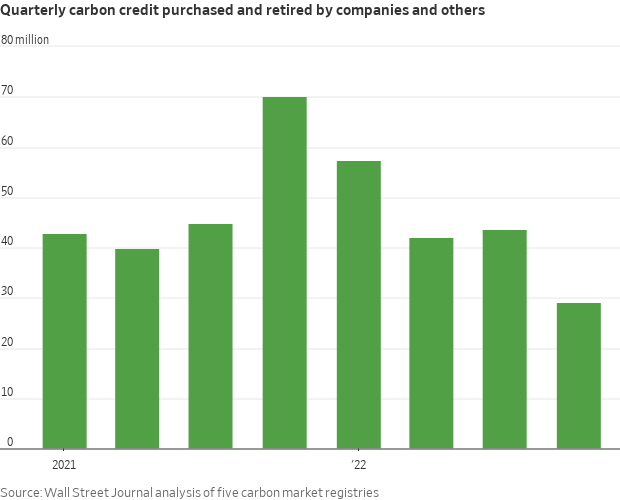
— Indonesia plans B35 fuel starting in 2023. Indonesia will raise its mandatory biodiesel blending to 35% as of Jan. 1, 2023, the country’s energy ministry announced, citing a push to reduce fuel imports amid high energy prices and making a shift to the use of cleaner energy. "The estimated demand for biodiesel to support B35 implementation is 13.15 million kiloliters, or around a 19% increase compared to 2022 allocation of 11.03 million kiloliters," energy ministry spokesperson Agung Pribadi said in a statement. Indonesia is estimated to consume 37.58 million kiloliters of diesel next year, Reuters said, with 35% from palm-based biodiesel. Indonesia’s biodiesel industry has a capacity of 16.65 million kiloliters, the energy ministry said. There will be new specifications for biodiesel to make sure the higher blend will not impair engine performance.
Indonesia also is expected to conclude its trial on B40 (40% palm oil) by year end. The increase has been signaled by the Indonesian government previously and the watch will now be on the timeline for deploying B40 fuel.
— Brazil court decision could increase ethanol use. A settlement reached by Brazil’s Supreme Court in a case opposing the federal government and Brazilian states about state-level taxation on fuels could lead to higher gasoline prices, and improved market conditions for ethanol. The federal government and the states agreed late on Wednesday to a proposed settlement that will continue to limit the so-called ICMS state tax on items considered “essential” such as diesel fuel, natural gas and cooking gas, but free up others. There will be no specific ceiling for some goods, including gasoline, leading the way for states to reinstate higher levies and recover lost revenue.
— California regulators approved an aggressive plan Thursday to achieve carbon neutrality in the state by 2045. The plan, approved by the California Air Resources Board (CARB), looks to move one of the world's largest economies to renewable energy and away from fossil fuels. The board said the plan will cut air pollution by 71% and gas emissions by 85%. Beginning in 2026, all new residential buildings will be required to install electric appliances and in 2029, the requirements will begin extending to commercial buildings, the plan states.
The board also previously approved a rule requiring all passenger vehicles sold in the state to be zero-emission by 2035.
— Virgin Atlantic today announced plans to fly a Boeing 787 from London to New York, powered solely by waste oils and fats, a move hailed as a step toward reducing aviation's significant environmental impact.
— Renewable energy funds. USDA announced $285 million in grants for 844 projects in 44 states through the Rural Energy for America Program and invited applications for an additional $300 million in grants for renewable energy and energy-efficiency projects.
|
LIVESTOCK, FOOD & BEVERAGE INDUSTRY |
— Bird flu continues to ravage poultry globally. The virus has reached five South American countries since October and wiped-out half of the U.K.’s free-range turkeys for Christmas.
— Holiday headaches. Shortages of pie crusts, gravy and other key holiday meal fare are looming in the U.S., according to a leader in the grocery industry. Link for more via Bloomberg.
— USDA wants to continue case-control study on HPAI in turkeys. USDA’s Animal and Plant Health Inspection Service (APHIS) is seeking to continue a case-control study on highly pathogenic avian influenza (HPAI) in turkeys that was started in 2022. APHIS is proposing to continue the study “to generate up-to-date information for determining current risk factors for infection with this environmentally hardy foreign animal disease pathogen. The information gathered comes from a multi-question survey administered to commercial turkey producers. USDA wants to continue the study for three more years.
Comments on the plan are due by Feb. 14. USDA noted in the Federal Register notice (link) seeking the extension that over 70% of all affected commercial farms in the U.S. are turkey farms. The study is needed to try and mitigate future infections, APHIS said, noting that evidence so far signals the 2022 infections have been “due to independent wild bird introductions.”
|
HEALTH UPDATE |
— Summary:
- Global Covid-19 cases at 652,064,114 with 6,662,271 deaths.
- U.S. case count is at 99,826,801 with 1,087,014 deaths.
- Johns Hopkins University Coronavirus Resource Center says there have been 657,927,289 doses administered, 267,654,789 have received at least one vaccine, or 81.23% of the U.S. population.
— U.S. intelligence agencies aren't prepared for another global health crisis, a House committee report says. The panel said the Director of National Intelligence’s office was slow to reorient clandestine intelligence collection assets to the outbreak as Covid-19 showed increasing signs of blossoming into a global pandemic.
— British nurses go on strike. Facing soaring inflation and acute staffing shortages, as many as 100,000 nurses in Britain went on strike for higher wages and improved working standards on Thursday. Thursday’s walkout was a historic one, marking the biggest strike on record for the Royal College of Nursing (RCN), the nurse’s union, as well as their first strike since the National Health Service was established in 1948.
|
POLITICS & ELECTIONS |
— Sinema files paperwork for independent Senate candidacy in 2024. The Wall Street Journal reports (link) Sen. Kyrsten Sinema (I-Ariz.) has filed paperwork as an independent candidate for 2024, though she has not said publicly that she will run for reelection. The move does not commit Sinema to a run, but it enables her to raise money.
|
CONGRESS |
— New Senate bill to overhaul agricultural visa system has “slim odds” of passing. Roll Call reports (link) Democratic Sen. Michael Bennet of Colorado unveiled long-awaited legislation Thursday to revise the agricultural visa system and offer migrant farmworkers a path to permanent residency — a last-ditch effort to enact changes after bipartisan talks fell apart. According to Roll Call, “The legislation largely mirrors the so-called Farm Workforce Modernization Act, a bill the House passed last year with more than two dozen Republican votes. But notably missing from Bennet’s bill is support from Sen. Mike Crapo, the Idaho Republican who has been negotiating with Bennet for nearly a year on the Senate version.” And, Roll Call points out, “Without a Republican backer in the Senate, Bennet’s bill could face slim odds in the evenly divided chamber, where bills need at least 60 votes to move forward and immigration bills get tangled in politics about U.S./Mexico border security.”
— The Jan. 6 select committee on Monday will present portions of the panel’s final report and vote on whether to issue criminal referrals during its final meeting. Committee leaders moved up the release of the final report from Wednesday to Monday. Chair Bennie Thompson (D-Miss.) said the executive summary and eight chapters of the report will be unveiled at the committee’s 1 p.m. ET meeting that day.
|
OTHER ITEMS OF NOTE |
— New IRS office to focus on tax and climate law implementation. A new IRS office will be devoted to overseeing the agency’s implementation of the 2022 tax-and-climate law, according to an IRS financial report released Thursday.
— The Biden administration has released a six-pillar plan to address a surge in migrant crossings anticipated after the scheduled end of Title 42 next week. It includes additional resources at the U.S./Mexico border, highlights consequences for unlawful entry and lists steps to improve processing efficiency, bolster nonprofit capacity, target smugglers and collaborate with international partners. According to the plan, the increase in resources to the southern border includes the hiring of nearly 1,000 Border Patrol processing coordinators and 2,500 contractors and personnel from government agencies. Expecting thousands of migrants' arrival daily, U.S. Customs and Border Protection will impose legal consequences on those who cross unlawfully and don't have a legal basis to stay in the U.S., the plan states.
— Cotton AWP falls back. The Adjusted World Price (AWP) for cotton fell to 72.52 cents per pound, effective today (Dec. 16), down from 75.17 cents per pound. But the rate remains more than 20 cents above the mark that would trigger any payments under the farm program.
— Twitter suspended the accounts of several journalists Thursday without publicly specifying why, the latest instance of the social-media platform making content or user decisions under Elon Musk without much transparency. The New York Times says not only could this raise the regulatory heat on Twitter, and possibly Musks’ other companies, it could also hurt his push to get reluctant advertisers back onto the platform. The suspensions have triggered a wave of protests. News organizations, including the NYT, and CNN, have demanded that Musk explain his rationale. Supporters of the journalists argued on Twitter that Musk’s latest move was overly punitive.
— As pickleball increases in popularity across the nation, cruise line Holland America Line is looking to retrofit every ship in its fleet with dedicated pickleball courts with top-deck views by February 2023. It’s the latest indicator of the travel sector looking to capitalize on the sport’s rapid growth, with everything from Airbnbs and resorts to parks and gyms debuting their own pickleball playing grounds. Link to more via Forbes.
|
KEY LINKS |
WASDE | Crop Production | USDA weekly reports | Crop Progress | Food prices | Farm income | Export Sales weekly | ERP dashboard | California phase-out of gas-powered vehicles | RFS | IRA: Biofuels | IRA: Ag | Student loan forgiveness | Russia/Ukraine war, lessons learned | Election predictions: Split-ticket | Congress to-do list | SCOTUS on WOTUS | SCOTUS on Prop 12 | New farm bill primer | China outlook |

